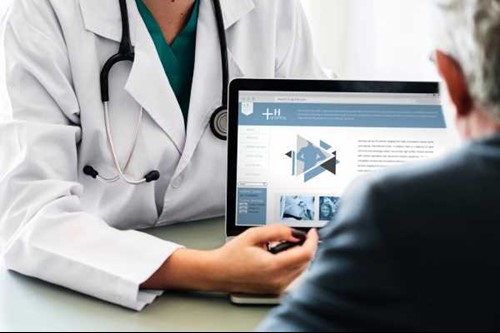
Healthcare Software Development Services - Top 7 Important Factors to Consider
Custom software development is increasingly recognized as an important part of healthcare businesses in the new digital economy. Generally speaking, healthcare software projects have a variety of industry-specific requirements that need to be met.
It’s important that healthcare organizations carefully plan and implement solutions that are secure, flexible, and integrate smoothly with the workflow of the different user groups who are going to use them.
Thus, there are specific challenges related to the development, integration, and security that need to be solved.
In this article, let’s examine a number of important aspects when it comes to software development that healthcare organizations should consider to prepare for their development project, ultimately reducing development costs, helping healthcare practitioners deliver better services, and enhance efficiencies within the organizations or clinical setting.

#1 Focus on usability and ease of use
First of all, healthcare employees are mostly people with a busy schedule, thus a user-friendly and easy-to-navigate interface is crucial to ensure a high user adoption rate. Otherwise, the investment in software development would go to waste. Additionally, healthcare institutions also need to prepare their employees (e.g. nurses, doctors, clinicians, etc.) for any changes in their working process that the new software solutions will bring about and provide adequate training and support, in order to derive the maximum benefits out of the solutions.
#2 Integration with various applications
Additionally, it’s also important to take into account the various system integration requirements to make sure the new solutions work with other systems, especially where many healthcare institutions are still employing on-premise, legacy applications for data recording and storage. This leads to the further question of whether the current legacy systems need to be updated/upgraded to integrate with the new solutions.
#3 Administration
For instance, a doctor may diagnose and find out that a patient was allergic to some particular medications and the new software solution should allow the doctor to update the patient’s records immediately to inform other clinicians for appropriate treatment. On the contrary, access to patients’ records should also be limited by functions, for example, only doctors with applicable rights assigned can view and/or prescribe medications.
#4 Information Security
One important aspect of adopting new technology solutions for healthcare businesses is that organizations need to incorporate appropriate measures for security purposes, to ensure compliance with laws on information, privacy, and other security standards. Breach of patient data is a serious issue that may cause heavy business loss. Corporate policy needs to govern the access to data and patient records, with only authorized personnel with rights can have access to the required information.
Need Help with Healthcare Software Development? Contact TP&P Technology - Leading Vietnam Software Outsourcing Company today
One way to safeguard sensitive data is to implement secure sign-in methods such as biometric log-in (e.g. fingerprints, facial recognition). However, this would require devices to support such features of facial recognition or fingerprint scanner. Furthermore, data should be encrypted when stored, or sent/received from devices to prevent misuse, or data snooping. In case of loss or theft of devices, other security methods can also be implemented include wiping data from the device remotely or automatically locked to prevent further use.
#5 The Importance of Mobile App Development for Healthcare Businesses
Mobile application has been proven to provide benefits to various businesses in different industries which include healthcare institutions and hospitals. Generally speaking, mobile app allows employees working in healthcare organizations to access data and files related to their patients in real-time and also update important patient information back to the healthcare system of records in real-time.
The ultimate goal of app development for healthcare organizations is to improve patient care and enhance the healthcare workflow. However, as mentioned previously, there are challenges associated with the development of mobile apps for healthcare. Most notably, development costs and choosing the right technologies and solutions are among the top concerns by healthcare management.
Let’s consider the financial aspect of investing in developing a mobile app for healthcare institutions and assess which approach makes the most financial sense:
The return on investment for mobile app development should be considered from the higher level, one that affects and transforming the overall operations.
One of the main objectives of mobility is to provide instant access to patient’s data and records, which helps reducing delay of services and unnecessary tests and treatments. Having access to patient’s records on-the-go also ensures information is available as and when required, improving clinical care with more accurate treatment, reducing costs for patients, and improves workflow efficiencies.
#6 Development Costs
If the investment for mobile application development is considered worthwhile, the next question asked is which mobile solution should healthcare institutions choose to develop and how to choose the investment decision should be made?
The development cost will depend on the size and complexity of the project which is based on the specific business needs of the healthcare business.
For example, a large hospital will have different mobile requirements compared to a private care practice. Healthcare organizations need to consider all the advantages that a mobile workforce can bring and how it allows their employees to achieve a better and more efficient workflow, ultimately enhancing productivity. With mobile applications, busy healthcare practitioners won’t have to be bound to their desks.
Before finalizing on the solution, it’s important that healthcare institutions carefully identify the key problems that need to be solved by the software solutions and pick one that is best suitable, meeting all the specific needs and stay within the budget.
Considerations should also be given to the long-term future IT needs of healthcare institutions, such as potential business expansion and its scalability and integration requirements.
#7 Healthcare IT infrastructure
Last but not least, there’s also the cost of IT infrastructure to consider such as: hardware, devices, internet connection speed, and/or mobile 4G connection, etc. one important decision that healthcare organizations need to consider is whether they will provide the devices or let employees use their own one?
Allowing employees to use their own mobile devices to access the app would compromise some of the security and concern, thus appropriate measures need to be implemented. However, this seems to be the preferred option as this allows employees to use the technologies and devices that they are familiar with, and this model can also reduce the investment costs for the organizations.
Another concern might be that users won’t update their as required for mobile solutions. Without the required hardware, a mobile app might not function properly. A flexible way to address this is to provide a set of corporate facilities devices for employees to use on a day-to-day basis during working hours and on-premises.
Conclusion:
New opportunities bring challenges, and there are always difficulties with adopting new technologies for businesses. However, in the long term, the benefits of employing new technologies will be greater than the challenges.



